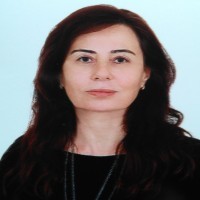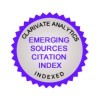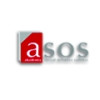Research Article
Letter to Editor
Aim & Scope
Journal Of Art History has the purposes of contributing to the information generation and knowledge accumulation on a scientific level in the field of Art History as well as the related fields such as art, cultural heritage and architecture; providing opportunities to discuss and debate on new findings and various aspects of the related fields; and it intends to be a platform enabling the researchers to present their studies to other researchers and the community.
The scope of the Journal is mainly the field of art history including Turkish & Islamic Arts, Byzantine Arts, Art of Europe and Contemporary Art branches and also fields of art (except for the literary arts, music, cinema, stage and performance arts) involving all other geographies and cultures of the world, architecture, tangible cultural heritage that has artistic aspects. The content of the journal includes the research and review papers written on the related subjects about the fields in question. Besides, letters to the editor, translations, and book reviews that the editorial board deems appropriate can be included. (Excavation, survey, restoration etc. reports, and inventories without review and comprehensive assessment are not accepted.)
Author Guidelines
SPELLING RULES and TECHNICAL POINTS
1. The original paper size of the Journal of Art History is 16,5 x 24 cm. However, it is suggested to prepare the articles in A4 size as MS Word document; leave 3 cm blank upside and bottom and 2 cm blank from right and left. The text must be written in 12 point Times New Roman font size with 1,2 pitch; the main headings must be arranged in bold and 13 point and the sub-headings of the text must be arranged in bold and 12,5 point. The paragraph style of the text must be set as “justified” and the first indent must be set as 1,25 cm. (There isn’t a certain limitation for page and visual material for the articles; however, it is requested that the document, which must be prepared in accordance with the beforementioned standards, does not exceed 30 pages in total.)
2. The name of the writer/writers, title and corporation information, Orcid ID, postal address, e-mail adress and phone number must be available on the cover page attached to the article. [In accordance with the “blind reviewing” principle, the article is sent to the reviewers anonymously. In case the process results favorably, the name of the writer and the related information are added to the first page of the article prepared appropriately for the publication.]
3. The title of the manuscript must be given in both Turkish & English on the top.
The titles should be followed by abstracts in both Turkish and English. The abstract should be in order that contains summaries of the main parts of the article (such as introduction, method, findings, evaluation, conclusion, discussion and suggestions...) to allow the reader able to understand the content of the article and to determine its relation to his / her interests. In the abstract, footnotes, tables, photographs etc. should not be used and should not be any referance to any page of the article. The "abstract" written in the language of the article should be at least 150 and at most 250 words. The "Abstract" in the foreign language of the article should be longer. It should be about 500 words.
Each abstract (Turkish & English) must have five keywords beneath.
4. The footnotes must have an automatic and coherent numbering added with the “add footnote” feature of MS Word; they must be presented under the page; must not be arranged in the form of “endnote.” (footnotes must be typed in Times New Roman fonts & 10 pt)
5. For the studies previously presented at a symposium or a congress but not published yet, the name, place and date of the symposium/congress must be indicated. If the article is the product of a research or a project supported by an institution, the project number must be stated. If the study is a compilation product of a doctorate or master thesis, it must be indicated.
6. If the article contains texts written in an alphabet aside from the Latin alphabet, for example if a special text font supporting Cyrillic, Arabic or Greek letters is used, it is important to specify the related font to the editor and add the font file to the delivery.
7. There must be a “bibliography” section at the end of the article. References to the sources must be given as footnotes; not within the text. (Note: Sources in the Bibliyography should be reaally used / referred within the text of the article.) Direct quotations e.g. expressions, sentences or paragraphs taken from a source must be enclosed in quotation marks. At the end of the quoted text, the source should be referred by a footnote.
Writing principles of the Bibliography and footnote (reference/attribution) are exemplified at the end of this section.
(In addition, authors should consider the explanations under the heading PLAGIARISM POLICY & EVALUATION PROCESS AND PRINCIPLES.)
8. The visual materials (photograph, picture, figure, drawing etc.) can be placed either within or at the end of the text. All the visual materials must have their own names/explanatory information. However, during the publishing process, the last makeup of the article shall be made by the editor. All of the visual materials must be uploaded in one of the jpeg, png, tiff formats and in an appropriate quality to publish (300 dpi, preferably), and then sent separate from the Word file containing the text. It should be paid attention that these files must be named in a consistent way with the reference within the text.
9. While writing the abbreviations used at the article, (for example, BC, AD, cm, Ph.D.) official abbreviation indexes of the language the article is written in (Turkish or English) must be adapted. (Besides this, when a reference is made to a component such as picture, photograph, figure, drawing within the text, the abbreviations pic., photo, fig., dwg. can be used.) Special/personal abbreviatons which do not exist at the guide and indexes must be defined at the end of the article.
10. The article text must be submitted through uploading to the system of DergiPark. [In order to perform this, the writers should check in for membership to system of DergiPark, join the Journal of Art History (https://dergipark.org.tr/std) on the system as the “user” and follow the uploading steps pressing the “submit a manuscript” button at the journal page.
[The "full text file" which contains the titles (Turkish and English), abstracts (Turkish and English), the main text part, vusual materials (if used) and the Bibliography must be uploaded. Besides a "plagiarism report" must be uploaded. (Preferably iTHENTICATE Reports. Turnitin Reports are not acceptable for the article.]
If the articles (especially table, italic/bold parts) contain such special fonts as Arabic, Ottoman Turkish, Greek, Chinese, creating a pdf copy of the document and adding to the post is proposed as a precaution against possible incompatibilities at the Word file.
---------------------------------------
EXAMPLES FOR WRITING PRINCIPLES OF
BIBLIOGRAPHY & REFERENCE/ATTRIBUTION
a- If a general reference is aforementioned within the text
Reference at the footnote: Çakmak, 2001
Indication At The Bibliography:
Çakmak, Ş. (2001), Erken Dönem Osmanlı Mimarisinde Taçkapılar, Ankara: Kültür Bakanlığı
b- An indication of a writer’s works of the same date
Reference at the footnote:
Daşçı, 2013a, 26 ve Daşçı, 2013b, 12
Indication At The Bibliography:
Daşçı, S. (2013a), İzmir’ Gelen Kadın Gezginler, Sanat Tarihi Dergisi XX /1, 1-37
Daşçı, S. (2013b). 19. Yüzyılda İzmir’de Dünyaya Gelen Bazı Gayrimüslim Ressamlar ve Sanatsal Etkinlikleri Hakkında Bir Değerlendirme, Sanat Tarihi Dergisi, XX /2, 1-18.
c- A work of two writers
Reference at the footnote: Bayrakal ve Daş, 2010, 27.
Indication At The Bibliography:
Bayrakal, S., Daş, E. (2010), Yelki (İzmir-Güzelbahçe) Mezarlığı, Sanat Tarihi Dergisi, XVII/2, 25-41.
d- A work of writers ranging from three to five:
Reference at the footnote
(All names at the first reference):
Altun, Carswell ve Öney, 1991, 86.
It’s enough to identify the first writer for the subsequent references: Altun et.all., 1991, 87.
Indication At The Bibliography:
Altun, A., Carswell, J. ve Öney, G. (1991), Türk Çini ve Seramikleri, İstanbul: Vehbi Koç Vakfı
e- A work of the two writers with the same surname:
Reference at the footnote: H. Çal ve Ö. Çal, 2008, 125.
Indication At The Bibliography:
Çal, H., Çal, Ö. (2008), Trakya Bölgesi Kapı Tokmakları ve Çekecekleri, Ankara: Atatürk Kültür Merkezi.
f- A work with 6 and more writers:
At the first reference, only an abbreviation is made in the form of only the first name and et. al. However at the bibliography, “et al” expression is used after presenting six names.
g- A quotation over the second source;
If the first source is unknown to the article writer, the reference is made to the second source.
At the bibliography, the personal record of the second source is presented.
Reference at the footnote: Transmitted from Ünal by Uçar, 2012, 1.
h- Anonymous books published by an institution:
The name of the institution, abbreviation and date are presented at the first reference.
At the subsequent references, only the abbreviation and date are presented.
First reference : Türk Dil Kurumu (TDK), 1999.
Subsequent references : TDK, 1999.
Indication at the bibliography: Türk Dil Kurumu. (2005), Türkçe Sözlük (10.bs.), Ankara: Türk Dil Kurumu.
ı- Translated Book :
Gombrich, E.H. (2011), Sanatın Öyküsü, E.Erduran, Ö. Erduran (Çev.), İstanbul: Remzi Kitabevi.
i- Book with an editor :
Cahoone, L. (Ed.). (1996), From Modernism to Postmodernism, Cambridge: Blackwell
j- Encyclopedia entry :
Ersoy, O. (1973), Kağıt ve Kağıtçılık, Türk Ansiklopedisi, 21, 112-115. Ankara:Milli Eğitim Bakanlığı.
k- Scholarly journal articles :
Indication At The Bibliography:
Çakın, İ. (2004), Müteferrika Matbaası’nın Düşündürdükleri ve Avrupa’da Basımcılığın Etkileri. Bilgi Dünyası, 5 (2), 153-167
l- Magazine Article :
Uslu, M. (Şubat 2013), Arjantinli Osmanlılar, Skylife, 14-25.
m- Newspaper Article :
Dündar, C. (15 Kasım 2011), Bir Canlı Tarih Kitabı Göçtü, Milliyet, 5.
n- Electronic source- Printed Article :
Yazıcı, N. (2010), Amasya’daki Hükümet Konağı Binaları [Elektronik Sürüm], Atatürk Üniversitesi Güzel Sanatlar Fakültesi Dergisi, 18, 91-105.
o- Article from Electronic Database :
Rogers, M. (1985), A Group of Ottoman Pottery in the Godman Bequest, The Burlington Magazine, 127, 134-145, Erişim (acsessed): 25.01.2012, Jstor.
ö- Thesis (Unpublished) :
Gök, S. (2000), Bursa’daki Türk Yapılarında Yer Alan Çini Süslemeli Örnekler, (Yayımlanmamış Yüksek Lisans Tezi), Ege Üniversitesi/Sosyal Bilimler Enstitüsü, İzmir
p- Declaration/Proceedings (Published) :
Kuyulu Ersoy, İ. (2007), Bornova Yerleşiminde Farklı Bir Üslup: Levanten Köşkleri. H. Karpuz ve O. Eravşar (Ed.), Konya Kitabı X, 353-359, Konya: Konya Ticaret Odası
r- Declaration / Proceedings (Unpublished):
Ersoy, B. (Nisan 2012), 2007-2011 Kale-i Tavas Kazı Çalışmaları Hakkında Düşünceler[Bildiri], Kaledavaz Sempozyumu. Kale
s- Poster Declaration/ Proceedings :
Kürüm, M., Doger, F. (Mayıs 2010), Tıp Tarihi Müzeleri [Poster], VI. Ulusal Tıp Eğitimi Kongresi, ADÜ Atatürk Kongre Merkezi
ş- Report: Investment Support and Promotion Agency (2010), Tourism Sector Report, Ankara: Republic of Turkey Prime Ministry Investment Support and Promotion Agency.
t- Laws and regulations : Kültür ve Tabiat Varlıklarını Koruma Kanunu, (1983), T.C. Resmi Gazete, 18113, 23 Temmuz 1983
u- Interviews :
are only made reference within the context.
Ethical Principles and Publication Policy
MAIN POINTS
Journal Of Art History is a scientific/scholarly, peer-reviewed journal, and is published biannually; in April and October.
The articles, which must certainly be original and which are prepared within the framework of the mentioned scope and purpose, can be indited in Turkish and English languages. The writers are acknowledged to undertake that the mentioned article is not published or sent to be published anywhere else, the article is clean in terms of ‘plagiarism’ and the visual-graphical materials such as photograph, drawing, picture, and document within the article content do not have any copyright issue.
Furthermore, the writers are considered to acknowledge that;
● The Journal of Art History do not carry a commercial quality; and therefore, the writers shall not be made any payment;
● Their article in the journal is also published at the “open access model,” where all of the internet users can view and download the document in pdf format through Dergipark, within the body of TÜBİTAK ULAKBİM and/or various national-international indexes;
and, in this respect, are considered to have authorized the Journal of Art History.
Besides, authors are allowed to use and reuse their articles under the CC-BY-NC-ND as the third party users.
PLAGIARISM POLICY & EVALUATION PROCESS AND PRINCIPLES
The articles sent to be published are expected to comply with the spelling, punctuational and general rules of the language they’re written in, as well as the spelling rules of the journal. The articles sent to the journal are first analyzed and approved by the editor and the publication board, within the framework of the relevant criteria, and then scanned for “plagiarism” by means of some softwares such as the iThenticate which is currently being used. In consequence of the scanning of the main text in the article, the rate of similiarity to another texts without references shall not pass 15%, with the exclusion of the bibliography and the references. It could be asked the author to improve the situation for the ratios between 10% and 30%. However, the article is rejected in case of similarities over 30% without references. In case of the similarity rate is more than 35%, even though references are shown, the article can be rejected by evaluating that the study is weak in terms of "originality" and "contribution to the field". (Currently, the report must be uploaded as a pdf document by the author during the submission process.)
! In the text of the article, in the context of the citation procedure, the following should be taken into consideration:
When the exact same text is to be taken directly from any source, the quoted sentences should be enclosed in quotation marks and reference information (source and page number) should be given in a footnote at the end. If an information or matter from any source is to be given indirectly or to be mentioned, for example:
Doğan Kuban states that the geographical features of the regions are decisive in housing design in a publication1, however, in another publication2 he emphasises the effect of etno-cultural factors; but what Ayda Arel claims are slightly different3.
as can be seen above, the reference information should be given via an apart footnotes at the end of each mention, intimation or implication.
Some authors create "collage"-style quotations by sequentially taking text from various sentences in different publications or sentences on different pages of a book, collating them, adding their own comments to some places; and they gives to the end of the paragraph only one footnote that includes the whole references. This method is not approved by the Journal of Art History.
Quotations and references and quotations style should not be ambiguous and complicated, and should clearly show the reader the source-origin-link in question without any confusion.
! In addition, the articles written on any materials from an official museum, library, archive or excavation, or that include an image of original work / situation / excavation area from those mantioned officals, must have a publication permission certificate or correspondence received from the relevant institution. During the submition process to the Journal, the certificate or correspondence copy must be uploaded as an addition to the article document. Failure to submit such a document could be the reason for the refusal of the study.
! The articles sent to the Journal are expected to comply with the COPE's ethical suggstions and the YÖK's "Scientific Research and Publication Ethics Instruction" .
Steps and Principles of the Evaluation Process
In case of the positive result of the “pre-review” phase; the article is sent to two reviewers in compliance with the “Double blind peer review” principle. In case of the contrast views of the two reviewers, a third reviewer is asked for opinion. (The reviewers are designated in accordance with the area of specialization, among the names listed under the title of Academic Advisory Board of the journal. In case of having an article with a specific subject out of the specialty of the scientists on the list, the relevant scientists are consulted.) The journal editor takes into consideration whether there is a conflict of field and/or interest between the reviewer and the author while choosing a referee. In cases that may disrupt the objective evaluation, another reviewer is appointed.
Accepting the articles to the publication programme is possible with at least two “positive reports” from the related scientific advisors/reviewers. In case of the equality of positive or negative reports of the reviewers, or in case of any hesitation, the decisions of the Editor and the Editorial Board could determine the result. During the mentioned assesment process, the writer could be asked to make the necessary revisions and corrections.
Conflict of Interest :
Articles to be published in our journal should not contain possible ethical problems that may later cause embarrassment / investigation. In this context, authors should also provide information about possible conflicts of interest in their work on the cover page that includes author-institution information at the beginning of the full text file. Potential addressees and reasons for the conflict of interest should be disclosed. A potential conflict of interest is caused by personal, financial, academic competition; it may even be due to differences in ideologies or beliefs. Therefore, authors who submit articles should provide information on the cover page about:
> Financial support (fund, donation, sponsorship) regarding their work;
> Commercial / financial relationships with potential for conflict of interest
> Whether there is an agreement with the sponsor or contracted institutions and persons that could make the research results suspicious in any way.
> Conflict of interest / potential disputes between the authors of the article
If there is no conflict of interest, it should also be stated in a sentence that there is no potential for conflict of interest.
___
(The legal and ethical responsibility of the articles, submitted for publishing and finally published in the journal upon accepting these conditions, belong the writer.)
Price Policy
The Journal of Art History, published by Ege University, is prepared by volunteers who are employees of Ege University. Those who prepare the journal (editors, editorial board, graphic designer etc.) and helpers and the reviewers are not paid for this work. Electronic publication and storage platform and evaluation automation and DOI privilege are provided by TUBITAK-ULAKBİM-DERGİPARK. Therefore, the Journal of Art History does not have a commercial aspect.
Art History Journal does not charge any fee from the author for article submission and publication; does not pay any fees to the author(s).
In addition, the Journal of Art History, which is published in an open access model, does not charge any fees from the readers.
Indexes
Citation Indexes
Other Indexes
Journal Boards
Editor in Chief

Editorial Board




 Web
Web
He was born on August 1, 1964, in Sarayköy (Denizli). He graduated from the Department of Archaeology and Art History, Faculty of Letters at Ege University in 1986. He began working as a Research Assistant in the same department in 1988. He completed his Master's degree in 1991 and his Doctorate in 1999. He currently serves as an Professor in the Department of Art History, Faculty of Letters, Ege University.
He has authored chapters in various books and numerous articles on Turkish architectural history, including the books “Portals in Early Ottoman Architecture (1300-1500)” (Ankara 2001), “Muğla Mosques and Masjids” (Muğla 2013), and “Birgi, the World City” (İzmir 2019).

English Language Editor
Lisans, yüksek lisans ve doktora derecelerini Ege Üniversitesi İngiliz Dili ve Edebiyatı'ndan almıştır. 2020 yılından beri İstanbul Topkapı Üniversitesi'nde Dr. Öğr. Üyesi olarak görev yapmaktadır. Araştırma alanları II. Dünya Savaşı sonrası tiyatrosu, Rönesans tiyatrosu ve Post-modern edebiyattır.













